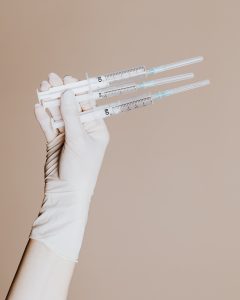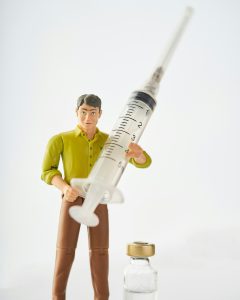
- What Is Diphenhydramine?
- Brief History of Diphenhydramine
- How to Use Diphenhydramine?
- What Should Be Done If an Overdose Occurs?
- To Whom Is It Contraindicated?
- Interactions with Other Medications
- Available Forms
- Famous Diphenhydramine Brands
- Why Do People Use It In Sports?
- Websites and Articles to Delve into the Benefits of Diphenhydramine
- Disclaimer
What Is Diphenhydramine?
Diphenhydramine is a first-generation antihistamine widely used to alleviate symptoms associated with allergies and as a sleep aid. As an antihistamine, it works by blocking the effects of histamine, a natural substance in the body that plays a key role in allergic reactions. Diphenhydramine is commonly found in over-the-counter allergy medications, cough and cold preparations, and sleep aids.
Beyond its antihistaminic properties, diphenhydramine has sedative effects, making it a common ingredient in sleep-inducing medications. Due to its sedative nature, it is sometimes utilized to manage short-term insomnia. However, its use as a sleep aid should be approached with caution, as prolonged or frequent use may lead to dependence and tolerance.
Diphenhydramine can cause drowsiness and impair cognitive function, so individuals taking it should avoid activities requiring mental alertness, such as driving or operating machinery. As with any medication, it is essential to follow recommended dosage guidelines and consult with a healthcare professional, especially in the presence of underlying health conditions or when used in combination with other medications.
Brief History of Diphenhydramine
Diphenhydramine, an antihistamine with sedative properties, has a history dating back to the mid-20th century. Here’s a brief overview:
- Discovery and Development:
- Diphenhydramine was first synthesized by George Rieveschl in 1943 while he was working at the University of Cincinnati.
- Initially developed as a compound to treat motion sickness, its antihistaminic properties were discovered during clinical trials.
- Introduction to the Market:
- The pharmaceutical company Parke-Davis introduced diphenhydramine to the market in 1946 under the brand name Benadryl.
- Benadryl was initially marketed as an allergy medication to relieve symptoms such as sneezing, runny nose, and itching.
- Antihistamine Use:
- Diphenhydramine’s antihistamine properties made it a popular choice for treating various allergic reactions, including hay fever and insect bites.
- It became a widely used over-the-counter medication for relieving allergy symptoms.
- Sedative Properties Recognized:
- The sedative effects of diphenhydramine were soon recognized, leading to its use as a sleep aid.
- Due to its sedative nature, diphenhydramine is sometimes included in over-the-counter sleep aid products.
- Diverse Applications:
- Over time, diphenhydramine found applications beyond allergy relief and sleep aid. It is used to manage symptoms associated with motion sickness, nausea, and as an ingredient in some cough and cold medications.
- Generic Availability:
- As the patent for Benadryl expired, generic versions of diphenhydramine became widely available, increasing its accessibility to consumers.
- Regulatory Considerations:
- Diphenhydramine is generally considered safe when used as directed. However, misuse or overdose can lead to adverse effects, and caution is advised, particularly regarding its sedative properties.
- Ongoing Use and Research:
- Diphenhydramine remains a commonly used medication for allergy relief, sleep aid, and related purposes.
- Ongoing research explores its potential applications and safety considerations.
| Year | Event |
|---|---|
| 1943 | Diphenhydramine synthesized by George Rieveschl. |
| 1946 | Introduction of diphenhydramine to the market by Parke-Davis under the brand name Benadryl. |
| Mid-20th Century | Recognized for antihistaminic properties and marketed as an allergy medication. |
| Ongoing | Widely used for allergy relief, recognized for sedative effects, and utilized as a sleep aid. |
| 21st Century | Generic versions become widely available as the patent for Benadryl expires. |
| Present | Diphenhydramine remains a common over-the-counter medication for various purposes, including allergy relief and sleep aid. Ongoing research explores its applications and safety considerations. |
This table provides a concise overview of key events in the history of Diphenhydramine. It’s important to note that this is a simplified overview, and more detailed information may be available in comprehensive histories or scientific literature related to diphenhydramine.
How to Use Diphenhydramine?
Diphenhydramine is commonly used to relieve allergy symptoms or as a sleep aid. Here are general guidelines on how to use diphenhydramine, but it’s crucial to follow the specific instructions provided on the product packaging or as directed by your healthcare provider:
- Read the Instructions:
- Carefully read the instructions on the packaging of the diphenhydramine product you have. Pay attention to dosage information, potential side effects, and any specific instructions.
- Dosage:
- Follow the recommended dosage as indicated on the product packaging or as prescribed by your healthcare provider. The dosage may vary based on the specific diphenhydramine product, the intended use, and individual factors.
- Swallow Whole:
- Swallow diphenhydramine tablets or capsules whole with a full glass of water. Do not crush or break the tablets unless directed otherwise.
- Timing:
- Take diphenhydramine as directed, typically before bedtime if using it as a sleep aid. If using it for allergy relief, take it as needed, following the recommended frequency.
- Avoid Alcohol:
- Limit or avoid the consumption of alcohol while taking diphenhydramine, as it can enhance the sedative effects and increase the risk of side effects.
- Food and Drink:
- Diphenhydramine can be taken with or without food. However, taking it with food may help minimize stomach upset.
- Be Mindful of Drowsiness:
- Diphenhydramine can cause drowsiness, so be cautious when engaging in activities that require mental alertness, such as driving or operating machinery. It’s often recommended to take diphenhydramine shortly before bedtime if using it as a sleep aid.
- Do Not Exceed Recommended Dosage:
- Avoid exceeding the recommended dosage, as excessive intake can lead to adverse effects.
- Consult with a Healthcare Professional:
- If you have any underlying health conditions, are pregnant or breastfeeding, or are taking other medications, consult with your healthcare provider before using diphenhydramine.
- Monitor for Side Effects:
- Be aware of potential side effects, including drowsiness, dry mouth, blurred vision, and constipation. If you experience severe or persistent side effects, contact your healthcare provider.
It’s important to note that diphenhydramine is not suitable for everyone, and its use as a sleep aid should be temporary. Chronic use can lead to tolerance and dependence. Always follow the advice of your healthcare provider, adhere to specific instructions, and use diphenhydramine responsibly.
What Should Be Done If an Overdose Occurs?
If an overdose of diphenhydramine is suspected, immediate medical attention is crucial. Diphenhydramine overdose can lead to serious health complications and may be life-threatening. Here are steps to take in the event of a suspected diphenhydramine overdose:
- Seek Emergency Medical Assistance:
- Call emergency services or go to the nearest emergency room immediately. Dial the emergency number in your country (e.g., 911 in the United States).
- Provide Information:
- Be prepared to provide information about the person, the amount of diphenhydramine taken, and any symptoms or reactions observed.
- Do Not Delay:
- Do not wait for symptoms to worsen before seeking help. Quick medical intervention is essential in cases of overdose.
- Monitor Vital Signs:
- While waiting for emergency medical services, monitor the person’s vital signs (breathing, pulse, consciousness). If they become unconscious or stop breathing, initiate CPR if you are trained to do so.
- Do Not Induce Vomiting:
- Do not try to induce vomiting unless directed by emergency personnel. Inducing vomiting can sometimes do more harm than good.
- Provide Medication Information:
- If possible, provide information about the diphenhydramine medication, including the strength, formulation (tablets, syrup, etc.), and any other relevant details.
- Follow Medical Advice:
- Follow the advice and instructions of healthcare professionals. They will determine the appropriate treatment based on the severity of the overdose and the individual’s condition.
Diphenhydramine overdose can lead to symptoms such as confusion, hallucinations, seizures, irregular heartbeats, and respiratory distress. Prompt medical attention is crucial to manage these symptoms and prevent complications.
It’s important to keep the packaging of medications for reference and inform healthcare professionals about any other medications or substances the person may have taken. If in doubt, seek emergency medical assistance immediately.
To Whom Is It Contraindicated?
Diphenhydramine is contraindicated, or should be used with caution, in certain individuals due to specific health conditions or factors. It’s important to consult with a healthcare professional before using diphenhydramine, especially if you have any of the following:
- Allergic Reaction:
- Individuals who have had an allergic reaction to diphenhydramine or any other antihistamines should avoid its use.
- Acute Asthma Attack:
- Diphenhydramine may exacerbate respiratory symptoms and is generally contraindicated during an acute asthma attack.
- Nursing Mothers:
- Diphenhydramine can pass into breast milk. While it is generally considered safe during breastfeeding, nursing mothers should consult with a healthcare provider before use.
- Closed-Angle Glaucoma:
- Diphenhydramine can worsen symptoms in individuals with closed-angle glaucoma, a condition affecting the eyes. It’s contraindicated in such cases.
- Prostate Enlargement (BPH):
- Diphenhydramine may worsen symptoms in individuals with an enlarged prostate (benign prostatic hyperplasia or BPH).
- Bladder Neck Obstruction:
- Diphenhydramine may cause urinary retention and is contraindicated in individuals with bladder neck obstruction.
- Severe Liver Disease:
- Individuals with severe liver disease may require dosage adjustments or should use diphenhydramine with caution.
- Pregnancy:
- While diphenhydramine is generally considered safe during pregnancy, pregnant individuals should consult with a healthcare provider before use.
- Elderly Individuals:
- Older adults may be more susceptible to the sedative effects of diphenhydramine, and caution should be exercised in this population.
- Central Nervous System Depression:
- Caution is advised when using diphenhydramine with other medications that depress the central nervous system, as additive sedative effects may occur.
Always consult with a healthcare professional before using diphenhydramine, especially if you have pre-existing medical conditions or are taking other medications. Individual cases may vary, and personalized advice from a healthcare professional is crucial to ensure safe and effective use of the medication.
Interactions with Other Medications
Diphenhydramine may interact with other medications, potentially affecting how each drug works or increasing the risk of side effects. It’s important to inform your healthcare provider about all medications, including prescription drugs, over-the-counter medications, vitamins, and herbal supplements, that you are taking. Here are some common interactions with diphenhydramine:
- Central Nervous System Depressants:
- Diphenhydramine may enhance the sedative effects of other medications that depress the central nervous system, such as benzodiazepines, certain sleep medications, or alcohol.
- Monoamine Oxidase Inhibitors (MAOIs):
- Concurrent use of diphenhydramine with MAOIs, a class of antidepressants, may increase the risk of side effects, including hypertensive crisis.
- Anticholinergic Medications:
- Diphenhydramine has anticholinergic effects, and combining it with other anticholinergic medications may result in additive effects. This can lead to increased dry mouth, blurred vision, constipation, and urinary retention.
- Medications with Sedative Effects:
- Combining diphenhydramine with other medications that have sedative effects, such as certain antipsychotics or muscle relaxants, may result in increased drowsiness.
- Antihypertensive Medications:
- Diphenhydramine may enhance the effects of antihypertensive medications, potentially causing a greater drop in blood pressure.
- Quinidine:
- Diphenhydramine may increase the levels of quinidine in the blood, leading to an increased risk of side effects associated with quinidine.
- Cimetidine:
- Cimetidine, a medication used to reduce stomach acid, may increase the blood levels of diphenhydramine, potentially intensifying its effects.
- Phenothiazines:
- Concurrent use of diphenhydramine with phenothiazines, a class of antipsychotic medications, may result in additive sedative effects.
- Urinary Retention Medications:
- Medications that can cause urinary retention, when combined with diphenhydramine, may increase the risk of urinary issues.
Always consult with your healthcare provider before starting or stopping any medications while using diphenhydramine. They can provide personalized advice based on your medical history and help you manage potential interactions safely. It’s crucial to be aware of potential drug interactions to ensure the safe and effective use of diphenhydramine.
Available Forms
Diphenhydramine is available in various forms to accommodate different preferences and needs. The primary forms of diphenhydramine include:
- Tablets and Capsules:
- Diphenhydramine is commonly available in tablet or capsule form. These are typically taken with water and swallowed whole.
- Oral Liquid/Syrup:
- Diphenhydramine syrup is available for those who may have difficulty swallowing tablets. It is often provided with a measuring device to ensure accurate dosage.
- Orally Disintegrating Tablets (ODT):
- ODTs are tablets that dissolve quickly in the mouth without the need for water. This form is convenient for individuals who may have difficulty swallowing traditional tablets.
- Topical Creams and Gels:
- Diphenhydramine is also available in topical forms, such as creams and gels, for the relief of itching and skin irritations caused by conditions like insect bites or rashes.
- Intramuscular (IM) or Intravenous (IV) Injections:
- In a medical setting, diphenhydramine can be administered via injection for more rapid effects, particularly in the treatment of severe allergic reactions.
- Combination Products:
- Diphenhydramine is sometimes included in combination with other medications, such as decongestants or pain relievers, to address multiple symptoms.
These various forms offer flexibility for individuals of different age groups, preferences, and health conditions. When choosing a specific form of diphenhydramine, consider factors such as the intended use, ease of administration, and individual preferences. Always follow the dosage instructions provided on the product packaging or as directed by a healthcare professional.
Famous Diphenhydramine Brands
Diphenhydramine is available under various brand names, both as a standalone medication and as part of combination products. Some well-known brands that contain diphenhydramine include:
- Benadryl:
- Benadryl is one of the most recognizable brands containing diphenhydramine. It is commonly used for allergy relief and as a sleep aid.
- Tylenol PM:
- Tylenol PM is a combination product that includes diphenhydramine for its sedative effects, along with acetaminophen for pain relief.
- Advil PM:
- Similar to Tylenol PM, Advil PM is a combination product that includes diphenhydramine and ibuprofen for pain relief.
- ZzzQuil:
- ZzzQuil is a brand that specifically focuses on sleep aids, and it often contains diphenhydramine as the active ingredient.
- Unisom:
- Unisom is a brand that offers various sleep aid products, and some formulations may contain diphenhydramine.
- Sominex:
- Sominex is another brand that offers sleep aid products, and diphenhydramine is a common active ingredient.
- Nytol:
- Nytol is a brand known for its sleep aid products, and certain formulations may include diphenhydramine.
It’s important to note that while these brands may contain diphenhydramine, they may also offer different formulations or variations with alternative active ingredients. Always read the product packaging and follow the recommended dosage instructions. Additionally, if you have any specific health concerns or are taking other medications, it’s advisable to consult with a healthcare professional before using products containing diphenhydramine.
Why Do People Use It In Sports?
Diphenhydramine is not commonly used as a performance-enhancing substance in sports. It is an antihistamine primarily used for the relief of allergy symptoms, as a sleep aid, and occasionally for its anti-itching properties. The sedative effects of diphenhydramine are more likely to impair performance rather than enhance it, making it an unlikely choice for athletes seeking a competitive advantage.
However, there might be instances where individuals involved in sports or physical activities consider using diphenhydramine for specific reasons:
- Allergy Relief:
- Athletes who suffer from allergies may use diphenhydramine to alleviate symptoms such as sneezing, itching, and runny nose that could otherwise impact their performance.
- Sleep Aid:
- Some athletes may use diphenhydramine as a sleep aid to address sleep-related issues, particularly if they are dealing with jet lag or struggling with sleep in unfamiliar environments during competitions.
- Anti-Itch Properties:
- Topical forms of diphenhydramine, such as creams or gels, might be used by athletes to relieve itching associated with insect bites or skin irritations.
It’s important to note that the use of diphenhydramine should be approached with caution in the context of sports. The sedative effects may impair coordination, reaction time, and overall performance. Moreover, athletes need to be aware of anti-doping regulations and the specific guidelines of sports organizations regarding the use of certain medications. Some substances, even those available over-the-counter, may be prohibited in competitive sports.
Athletes should always consult with their healthcare providers before using any medication, including diphenhydramine, to ensure its safety and legality in their particular sport.
Websites and Articles to Delve into the Benefits of Diphenhydramine
Diphenhydramine is an antihistamine used to relieve symptoms of allergy, hay fever, and the common cold. It is also used as a sleep aid, to relieve symptoms of motion sickness, and to treat mild cases of Parkinson’s disease. Here is some information from various sources:
- WebMD:
- WebMD provides detailed information on diphenhydramine, including its uses, side effects, precautions, and interactions.
- Wikipedia:
- Wikipedia offers an overview of diphenhydramine, covering its history, mechanism of action, and various uses.
- Drugs.com:
- Drugs.com provides comprehensive information on diphenhydramine, including its uses, side effects, and interactions with other drugs.
- NCBI Bookshelf:
- NCBI Bookshelf offers detailed professional information on diphenhydramine, including its pharmacology, therapeutic uses, and adverse effects.
- NHS (National Health Service, UK):
- NHS provides information on diphenhydramine, including its uses, dosage, and potential side effects.
- MedlinePlus:
- MedlinePlus offers consumer-friendly information on diphenhydramine, its uses, and potential side effects.
- Cleveland Clinic:
- Cleveland Clinic provides information on diphenhydramine in capsule or tablet form, including usage guidelines.
- Verywell Health:
- Verywell Health discusses the use of diphenhydramine, particularly in children, focusing on safety considerations.
- Medical News Today:
- Medical News Today provides an overview of diphenhydramine, its uses, and professional information.
- GoodRx:
- GoodRx offers information on diphenhydramine, including what it is and potential cost-saving options.
- MedicineNet:
- MedicineNet provides information on diphenhydramine, its uses, and potential side effects.
These sources collectively offer a comprehensive overview of diphenhydramine, covering its uses, safety considerations, potential side effects, and other relevant information. Always consult with a healthcare professional for personalized advice based on specific health needs.
Disclaimer
The information is solely provided for educational purposes. It is not intended to diagnose, treat, cure, or prevent any disease. Seek the advice of your physician or qualified healthcare provider with any questions you may have regarding a medical condition at all times. Never disregard professional medical advice because of something you have read or learned from this article.






